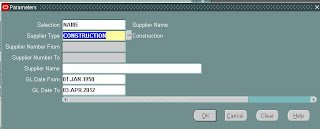Introduction :
For single records transaction Oracle suggest to use the application and
provides open interface and public APIs for bulk transaction.
provides open interface and public APIs for bulk transaction.
webADI is another strong feature provided by Oracle for bulk operations,
which allows user to provide input in MS application (Word or Excel..etc).
which allows user to provide input in MS application (Word or Excel..etc).
Why WebADI ? :
It requires technical expertise for both interface and API usages.
For interface user should know to insert all transactional data into interface table and API needs transactional data to be imported in any portable format to server.
WebADI does not have such technical dependency as it is available to user as function and Launch desktop integrator (Excel) to feed transactional data.
This provides reporting option also.
How It works :
For this one interface package required to do initial validations.
Post it we can use any of options -
1) Either insert all data into Interface Tables and run the Import
Program Manually
Program Manually
2) Call API inside the interface program and do transactions directly
Components :
1) Integrator - Basic definition and includes user name, internal
name and application name
name and application name
2) Interface - Most Important section , which directs data to flow (can
be either of Table or Procedure/Function type)
be either of Table or Procedure/Function type)
3) Content - This is required if webADI is being used for reporting
purpose also
purpose also
4) Upload - Controls the upload options
5) Importer – Definition of import options
6) Layout - Attributes arrangement on excel
Responsibility - Desktop Integration Manager




